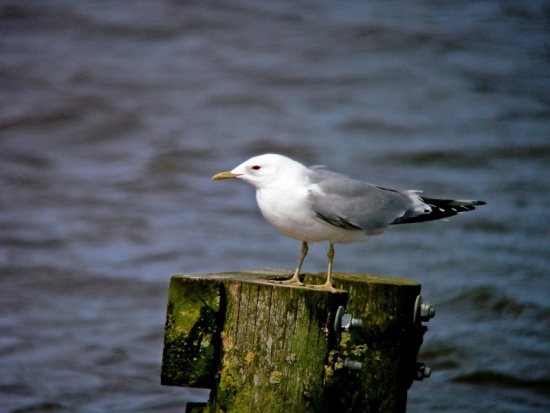| Line 1: | Line 1: | ||
;Larus canus | ;Larus canus | ||
[[Image:Common_Gull.jpg|thumb|550px|right|Photo by Rob Van Keulen]] | [[Image:Common_Gull.jpg|thumb|550px|right|Photo by Rob Van Keulen]] | ||
| + | |||
| + | |||
| + | ==Identification== | ||
AKA Common Gull | AKA Common Gull | ||
| − | + | Grey above, white below, green legs, black wing-tips. Young birds have black-brown upperparts. | |
| − | + | ||
==Distribution== | ==Distribution== | ||
| − | + | [[North America]], [[Europe]] and [[Asia]]. | |
==Taxonomy== | ==Taxonomy== | ||
Please notice that the once-split subspecies brachyrhynchus (the new world form) has now again been lumped with ''Larus canus''. The common name Mew Gull is recommended by all the major taxonomic authorities for the merged species, even though this species continues to be known as Common Gull in [[Europe]]. The only world-wide authotiry to recognize the split of Mew Gull from Common Gull was the 1996 installment of Sibley and Monroe. | Please notice that the once-split subspecies brachyrhynchus (the new world form) has now again been lumped with ''Larus canus''. The common name Mew Gull is recommended by all the major taxonomic authorities for the merged species, even though this species continues to be known as Common Gull in [[Europe]]. The only world-wide authotiry to recognize the split of Mew Gull from Common Gull was the 1996 installment of Sibley and Monroe. | ||
| Line 12: | Line 15: | ||
This species is subdivided into four subspecies: ''canus'' is the form familiar to people in [[Britain]] and [[Europe]]; ''heinei'' is breeding in [[Russia]] and large parts of [[Siberia]]; ''kamptschatschensis'' in north-eastern Siberia; and ''brachyrhynchus'' in [[Alaska]] and western [[Canada]] (this form has also been called Short-billed Gull). | This species is subdivided into four subspecies: ''canus'' is the form familiar to people in [[Britain]] and [[Europe]]; ''heinei'' is breeding in [[Russia]] and large parts of [[Siberia]]; ''kamptschatschensis'' in north-eastern Siberia; and ''brachyrhynchus'' in [[Alaska]] and western [[Canada]] (this form has also been called Short-billed Gull). | ||
==Habitat== | ==Habitat== | ||
| − | + | Near water or in marshes. | |
==Behaviour== | ==Behaviour== | ||
| − | + | They scavenge as well as hunt small prey. | |
| + | |||
| + | They make a lined nest on the ground or in a tree. | ||
==Bird Song== | ==Bird Song== | ||
Revision as of 14:50, 19 October 2007
- Larus canus
Identification
AKA Common Gull
Grey above, white below, green legs, black wing-tips. Young birds have black-brown upperparts.
Distribution
North America, Europe and Asia.
Taxonomy
Please notice that the once-split subspecies brachyrhynchus (the new world form) has now again been lumped with Larus canus. The common name Mew Gull is recommended by all the major taxonomic authorities for the merged species, even though this species continues to be known as Common Gull in Europe. The only world-wide authotiry to recognize the split of Mew Gull from Common Gull was the 1996 installment of Sibley and Monroe.
This species is subdivided into four subspecies: canus is the form familiar to people in Britain and Europe; heinei is breeding in Russia and large parts of Siberia; kamptschatschensis in north-eastern Siberia; and brachyrhynchus in Alaska and western Canada (this form has also been called Short-billed Gull).
Habitat
Near water or in marshes.
Behaviour
They scavenge as well as hunt small prey.
They make a lined nest on the ground or in a tree.
Bird Song
<flashmp3>Larus canus (song).mp3</flashmp3>
Listen in an external program




